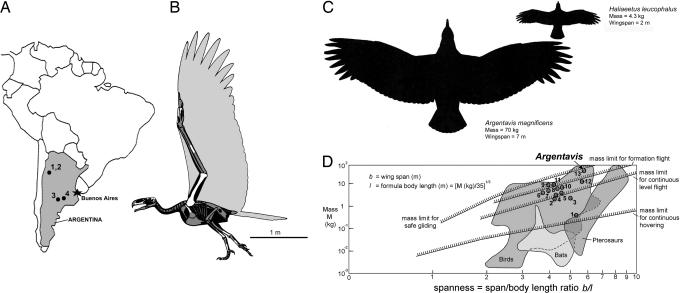Fig. 1.
Location and size of Argentavis. (A) Map of Argentina showing four fossil localities of Argentavis from upper Miocene deposits (≈6 Ma); 1 and 2, Andalhualá Formation, near Catamarca in Valle de Santa Maria in the foothills of the Andes; and the Epecuén Formation at 3, Carhué; and 4, near Salinas Grandes de Hidalgo in the Argentinean pampas (simplified from ref. 8). (B) Skeletal restoration of Argentavis showing the known elements by white, based upon corresponding bones of Teratornis merriami in the Natural History Museum of Los Angeles County. (C) Dorsal wing profile in silhouette of Argentavis is compared for scaling with those of a Bald Eagle (after ref. 9). (D) Relation between mass and spanness of three groups of flyers (birds, bats, and pterosaurs) occupying their distinct areas in the chart, each showing the range of their flying styles as size increases. The chart shows four sloping hatched bands, the lower edges of which correspond to the theoretical estimates in the upper mass limits, respectively; note that Argentavis occupies the upper size limit of gliding flight (after ref. 11). Numbers next to circles in the bird island correspond to 13 species of soaring landbirds listed in Table 1 (modified from ref. 15).

